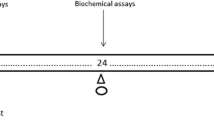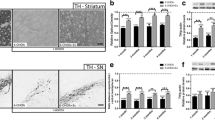Summary
The aim of the study was to find out whether the reserpineinduced rigidity is similar to that seen in parkinsonism. Simultaneous measurements of the muscle resistance of the hind foot to passive bending and stretching in the ankle joint, as well as of the electromyographic (EMG) activity of the gastrocnemius and tibialis anterior muscles of rats were carried out. Reserpine was injected in a dose of 10 mg/kg alone or with α-methyl-p-tyrosine (250 mg/kg) 1,4 and 27.5 h before the measurements. Reserpine increased the muscle resistance of the rat's hind leg to passive movements. That effect was the strongest at 1–2 h after the injections, and diminished markedly afterwards. The rigidity was accompanied with an increase in the resting, as well as in the stretch-induced short-and long-latency EMG activity in the gastrocnemius muscle. However, the intensity of the latter symptom did not change for a long period of time, which seems to correlate with the striatal dopamine depletion. The results suggest that the reserpine-increased EMG activity is a good model of parkinsonian rigidity.
Similar content being viewed by others
References
Bean AJ, Adrian TE, Modlin IM, Roth RH (1989) Dopamine and neurotensin storage in colocalized and non-colocalized neuronal populations. J Parmacol Exp Ther 249: 681–687
Berardelli A, Sabra AF, Hallett M (1983) Physiological mechanisms of rigidity in Parkinson's disease. J Neurol Neurosurg Psychiatry 46: 45–53
Bergui M, Lopiano L, Paglia G, Quattrocolo G, Scarzella L, Bergamasco B (1992) Stretch reflex of quadriceps femoris and its relation to rigidity in Parkinson's disease. Acta Neurol Scand 86: 226–229
Burke D, Hagbarth KE, Wallin BG (1977) Reflex mechanisms in Parkinson's rigidity. Scand J Rehab Med 9: 15–23
Colpaert FC (1987) Pharmacological characteristics of tremor, rigidity and hypokinesia induced by reserpine in rat. Neuropharmacology 26: 1431–1440
Davidoff RA (1992) Skeletal muscle tone and the misunderstood stretch reflex. Neurology 42: 951–963
Delwaide PJ, Sabbatino M, Delwaide C (1986) Some pathophysiological aspects of the parkinsonian rigidity. J Neural Transm 22: 129–139
Elverfors A, Nissbrandt H (1991) Reserpine-insensitive dopamine release in the substantia nigra? Brain Res 557: 5–12
Fornstedt B, Carlsson A (1989) A marked rise in 5-S-cysteinyl-dopamine levels in guineapig striatum following reserpine treatment. J Neural Transm 76: 155–161
Goldstein JM, Barnett A, Malick JB (1975) The evaluation of anti-parkinson drugs on reserpine-induced rigidity in rats. Eur J Pharmacol 33: 183–188
Grossman W, Jurna I, Nell T, Theres C (1973) The dependence of the anti-nociceptive effect of morphine and other analgesic agents on spinal motor activity after central monoamine depletion. Eur J Pharmacol 24: 67–77
Johnels B (1983) Reserpine-induced rigidity in rats: drug effects on muscle tone from corpus striatum and nucleus accumbens. Pharmacol Biochem Behav 19: 463–470
Johnels B, Steg G (1982) A mechanographic method for measurement of muscle tone in the conscious rat. The calf muscle stretch response in reserpine-induced rigidity. J Neurosci Meth 6: 1–16
Johnels B, Steg G, Ungerstedt U (1978) A method for mechanographical recording of muscle tone in the rat: the effect of some antiparkinsonian drugs on rigidity induced by reserpine. Brain Res 140: 177–181
Jurna I (1976) Striatal monoamines and reserpine and chlorpromazine rigidity. Pharmacol Ther 2: 113–128
Klockgether T, Turski L (1990) NMDA antagonists potentiate antiparkinsonian actions of 1-DOPA in monoamine-depleted rats. Ann Neurol 28: 539–546
Kolasiewicz W, Baran J, Wolfarth S (1987) Mechanographic analysis of muscle rigidity after morphine and haloperidol: a new methodological approach. Naunyn Schmiedebergs Arch Pharmacol 335: 449–453
Lee RG (1989) Pathophysiology of rigidity and akinesia in Parkinson's disease. Eur Neurol 29 [Suppl 1]: 13–18
Lee RG, Tatton WG (1975) Motor responses to sudden limb displacements in primates with specific CNS lesions and in human patients with motor system disorders. Can J Neurol Sci 2: 285–293
Matthews PB (1991) The human stretch reflex and the motor cortex. Trends Neurosci 14: 87–91
Meara RJ, Cody FWJ (1992) Relationship between electromyographic activity and clinically assessed rigidity studied at the wrist joint in Parkinson's disease. Brain 115: 1167–1180
Morrison AB, Webster RA (1973) Reserpine rigidity and adrenergic neurones. Neuropharmacology 12: 725–733
Mortimer JA, Webster DD (1979) Evidence for a quantitative association between EMG stretch responses and parkinsonian rigidity. Brain Res 162: 169–173
Ossowska K (1994) The role of excitatory amino acids in experimental models of Parkinson's disease. J Neural Transm [P-D Sect] 8: 39–71
Ossowska K, Lorenc-Koci E, Wolfarth S (1994) Antiparkinsonian action of MK-801 on the reserpine-induced rigidity: a mechanomyographic analysis. J Neural Transm [P-D Sect] 7: 143–152
Rothwell JC, Obeso JA, Traub MM, Marsden CD (1983) The behaviour of the longlatency stretch reflex in patients with Parkinson's disease. J Neurol Neurosurg Psychiatry 46: 35–44
Scholz E, Diener HC, Noth J, Friedemann H, Dichgans J, Bacher M (1987) Medium and long latency EMG responses in leg muscles: Parkinson's disease. J Neurol Neurosurg Psychiatry 50: 66–70
Starr MS, Starr BS (1994) Potentiation of dopamine-dependent locomotion by clonidine in reserpine treated mice is restricted to D2 agonists. J Neural Transm [PD-Sect] 7: 133–142
Tatton WG, Bedingham W, Verrier MC, Blair RDG (1984) Characteristic alterations in responses to imposed wrist displacement in Parkinsonian rigidity and dystonia musculorum deformans. Can J Neurol Sci 11: 281–287
Tracey DJ, Walmsley B, Brinkman J (1980) Long-loop reflexes can be obtained in spinal monkeys. Neurosci Lett 18: 59–65
Wolfarth S, Kolasiewicz W, Ossowska K, Bober M (1992) Direct mechanomyographic measurement of myorelaxant action of baclofen and diazepam in normal and reserpinized rats. Naunyn Schmiedebergs Arch Pharmacol 345: 209–212
Author information
Authors and Affiliations
Rights and permissions
About this article
Cite this article
Lorenc-Koci, E., Ossowska, K., Wardas, J. et al. Does reserpine induce parkinsonian rigidity?. J Neural Transm Gen Sect 9, 211–223 (1995). https://doi.org/10.1007/BF02259662
Received:
Accepted:
Issue Date:
DOI: https://doi.org/10.1007/BF02259662




